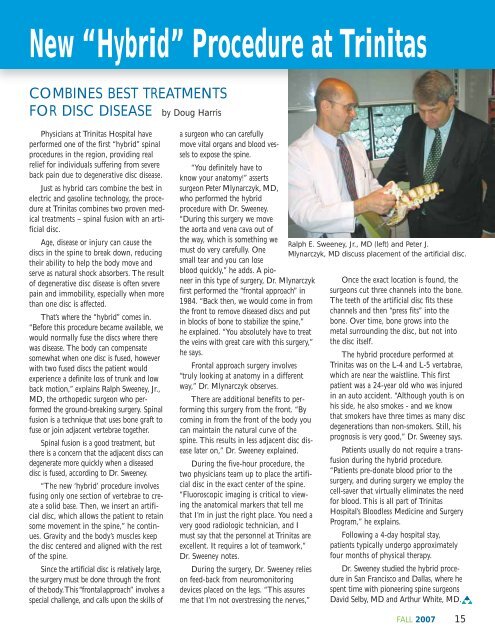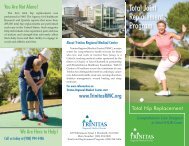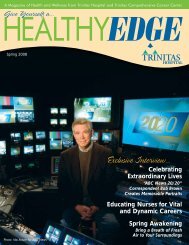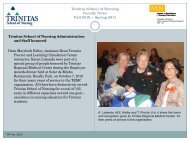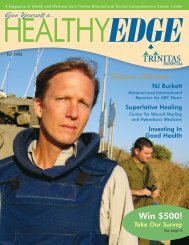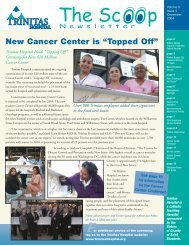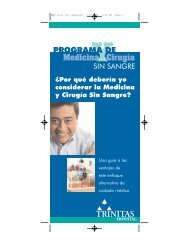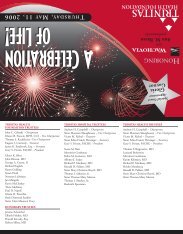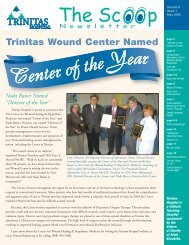Exclusive Interview⦠- Trinitas Hospital
Exclusive Interview⦠- Trinitas Hospital
Exclusive Interview⦠- Trinitas Hospital
- No tags were found...
Create successful ePaper yourself
Turn your PDF publications into a flip-book with our unique Google optimized e-Paper software.
New “Hybrid” Procedure at <strong>Trinitas</strong>by Doug HarrisCOMBINES BEST TREATMENTSFOR DISC DISEASE by Doug HarrisPhysicians at <strong>Trinitas</strong> <strong>Hospital</strong> haveperformed one of the first “hybrid” spinalprocedures in the region, providing realrelief for individuals suffering from severeback pain due to degenerative disc disease.Just as hybrid cars combine the best inelectric and gasoline technology, the procedureat <strong>Trinitas</strong> combines two proven medicaltreatments – spinal fusion with an artificialdisc.Age, disease or injury can cause thediscs in the spine to break down, reducingtheir ability to help the body move andserve as natural shock absorbers. The resultof degenerative disc disease is often severepain and immobility, especially when morethan one disc is affected.That’s where the “hybrid” comes in.“Before this procedure became available, wewould normally fuse the discs where therewas disease. The body can compensatesomewhat when one disc is fused, howeverwith two fused discs the patient wouldexperience a definite loss of trunk and lowback motion,” explains Ralph Sweeney, Jr.,MD, the orthopedic surgeon who performedthe ground-breaking surgery. Spinalfusion is a technique that uses bone graft tofuse or join adjacent vertebrae together.Spinal fusion is a good treatment, butthere is a concern that the adjacent discs candegenerate more quickly when a diseaseddisc is fused, according to Dr. Sweeney.“The new ‘hybrid’ procedure involvesfusing only one section of vertebrae to createa solid base. Then, we insert an artificialdisc, which allows the patient to retainsome movement in the spine,” he continues.Gravity and the body’s muscles keepthe disc centered and aligned with the restof the spine.Since the artificial disc is relatively large,the surgery must be done through the frontof thebody.This“frontalapproach” involves aspecial challenge, and calls upon the skills ofa surgeon who can carefullymove vital organs and blood vesselsto expose the spine.“You definitely have toknow your anatomy!” assertssurgeon Peter Mlynarczyk, MD,who performed the hybridprocedure with Dr. Sweeney.“During this surgery we movethe aorta and vena cava out ofthe way, which is something wemust do very carefully. Onesmall tear and you can loseblood quickly,” he adds. A pioneerin this type of surgery, Dr. Mlynarczykfirst performed the “frontal approach” in1984. “Back then, we would come in fromthe front to remove diseased discs and putin blocks of bone to stabilize the spine,”he explained. “You absolutely have to treatthe veins with great care with this surgery,”he says.Frontal approach surgery involves“truly looking at anatomy in a differentway,” Dr. Mlynarczyk observes.There are additional benefits to performingthis surgery from the front. “Bycoming in from the front of the body youcan maintain the natural curve of thespine. This results in less adjacent disc diseaselater on,” Dr. Sweeney explained.During the five-hour procedure, thetwo physicians team up to place the artificialdisc in the exact center of the spine.“Fluoroscopic imaging is critical to viewingthe anatomical markers that tell methat I’m in just the right place. You need avery good radiologic technician, and Imust say that the personnel at <strong>Trinitas</strong> areexcellent. It requires a lot of teamwork,”Dr. Sweeney notes.During the surgery, Dr. Sweeney relieson feed-back from neuromonitoringdevices placed on the legs. “This assuresme that I’m not overstressing the nerves,”Ralph E. Sweeney, Jr., MD (left) and Peter J.Mlynarczyk, MD discuss placement of the artificial disc.Once the exact location is found, thesurgeons cut three channels into the bone.The teeth of the artificial disc fits thesechannels and then “press fits” into thebone. Over time, bone grows into themetal surrounding the disc, but not intothe disc itself.The hybrid procedure performed at<strong>Trinitas</strong> was on the L-4 and L-5 vertabrae,which are near the waistline. This firstpatient was a 24-year old who was injuredin an auto accident. “Although youth is onhis side, he also smokes - and we knowthat smokers have three times as many discdegenerations than non-smokers. Still, hisprognosis is very good,” Dr. Sweeney says.Patients usually do not require a transfusionduring the hybrid procedure.“Patients pre-donate blood prior to thesurgery, and during surgery we employ thecell-saver that virtually eliminates the needfor blood. This is all part of <strong>Trinitas</strong><strong>Hospital</strong>’s Bloodless Medicine and SurgeryProgram,” he explains.Following a 4-day hospital stay,patients typically undergo approximatelyfour months of physical therapy.Dr. Sweeney studied the hybrid procedurein San Francisco and Dallas, where hespent time with pioneering spine surgeonsDavid Selby, MD and Arthur White, MD.FALL 2007 15


